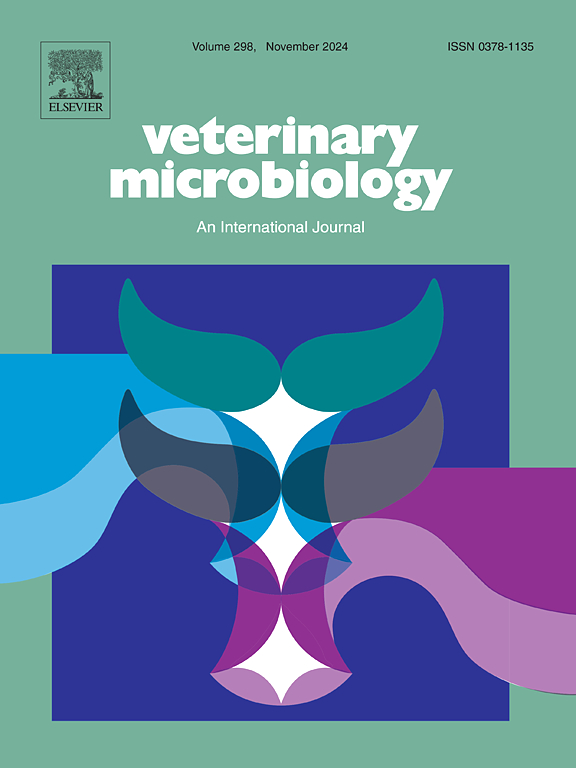Assessment of real-time PCR test in oral fluid samples for screening the serotypes of Actinobacillus pleuropneumoniae circulating in swine herds
IF 2.7
2区 农林科学
Q3 MICROBIOLOGY
引用次数: 0
Abstract
Actinobacillus pleuropneumoniae is the etiological agent of porcine pleuropneumonia, causing remarkable economic losses in the global swine industry. The diversity of A. pleuropneumoniae is generally determined through serotype identification, which is commonly employed for control strategies and surveillance. However, serological methods currently in use still have significant limitations. This study explores the use of real-time polymerase chain reaction (qPCR) to detect circulating serotypes of A. pleuropneumoniae in non-diseased swine herds through testing of oral fluids.
The study included three A. pleuropneumoniae-positive and three A. pleuropneumoniae-negative farms located in Quebec, Canada. Tonsil brushings, microbiological growths, and oral fluids were analyzed using qPCR to detect A. pleuropneumoniae and its distinct serotypes. Serological tests were performed using the LPS ELISA available at that time. In negative farms the absence of A. pleuropneumoniae and any serotype confirmed the specificity of the method. Positive farms, on the other hand, confirmed also the sensitivity of the analysis, with oral fluid samples consistently yielding positive results for the serotypes identified by ELISA.
The qPCR test conducted on oral fluids offers a noninvasive and cost-effective method for monitoring, complementing traditional serological techniques. It provides qualitative information about serotype distribution, facilitating proactive surveillance and control strategies.
评估口腔液样本中用于筛查猪群中流行的胸膜肺炎放线杆菌血清型的实时 PCR 检测。
胸膜肺炎放线杆菌是猪胸膜肺炎的病原体,给全球养猪业造成了巨大的经济损失。胸膜肺炎放线杆菌的多样性一般通过血清型鉴定来确定,通常用于控制策略和监测。然而,目前使用的血清学方法仍有很大的局限性。本研究探讨了使用实时聚合酶链反应(qPCR)通过检测口腔液来检测未发病猪群中胸膜肺炎甲虫的循环血清型。这项研究包括位于加拿大魁北克省的三个胸膜肺炎甲虫阳性猪场和三个胸膜肺炎甲虫阴性猪场。使用 qPCR 对扁桃体刷片、微生物生长物和口腔液进行分析,以检测胸膜肺炎甲虫及其不同的血清型。使用当时可用的 LPS 酶联免疫吸附法进行血清学检测。阴性猪场不存在胸膜肺炎甲虫和任何血清型,证实了该方法的特异性。另一方面,阳性猪场也证实了该分析方法的灵敏度,口腔液样本对 ELISA 法确定的血清型均呈阳性结果。对口腔液进行的 qPCR 检测提供了一种无创、经济的监测方法,是对传统血清学技术的补充。它提供了有关血清型分布的定性信息,有助于采取主动监测和控制策略。
本文章由计算机程序翻译,如有差异,请以英文原文为准。
求助全文
约1分钟内获得全文
求助全文
来源期刊

Veterinary microbiology
农林科学-兽医学
CiteScore
5.90
自引率
6.10%
发文量
221
审稿时长
52 days
期刊介绍:
Veterinary Microbiology is concerned with microbial (bacterial, fungal, viral) diseases of domesticated vertebrate animals (livestock, companion animals, fur-bearing animals, game, poultry, fish) that supply food, other useful products or companionship. In addition, Microbial diseases of wild animals living in captivity, or as members of the feral fauna will also be considered if the infections are of interest because of their interrelation with humans (zoonoses) and/or domestic animals. Studies of antimicrobial resistance are also included, provided that the results represent a substantial advance in knowledge. Authors are strongly encouraged to read - prior to submission - the Editorials (''Scope or cope'' and ''Scope or cope II'') published previously in the journal. The Editors reserve the right to suggest submission to another journal for those papers which they feel would be more appropriate for consideration by that journal.
Original research papers of high quality and novelty on aspects of control, host response, molecular biology, pathogenesis, prevention, and treatment of microbial diseases of animals are published. Papers dealing primarily with immunology, epidemiology, molecular biology and antiviral or microbial agents will only be considered if they demonstrate a clear impact on a disease. Papers focusing solely on diagnostic techniques (such as another PCR protocol or ELISA) will not be published - focus should be on a microorganism and not on a particular technique. Papers only reporting microbial sequences, transcriptomics data, or proteomics data will not be considered unless the results represent a substantial advance in knowledge.
Drug trial papers will be considered if they have general application or significance. Papers on the identification of microorganisms will also be considered, but detailed taxonomic studies do not fall within the scope of the journal. Case reports will not be published, unless they have general application or contain novel aspects. Papers of geographically limited interest, which repeat what had been established elsewhere will not be considered. The readership of the journal is global.
 求助内容:
求助内容: 应助结果提醒方式:
应助结果提醒方式:


